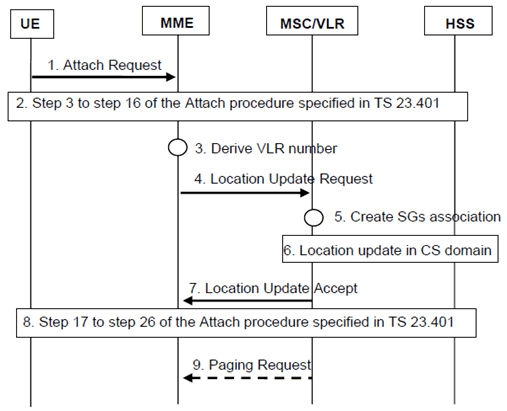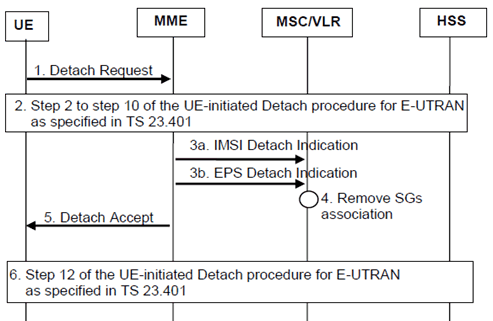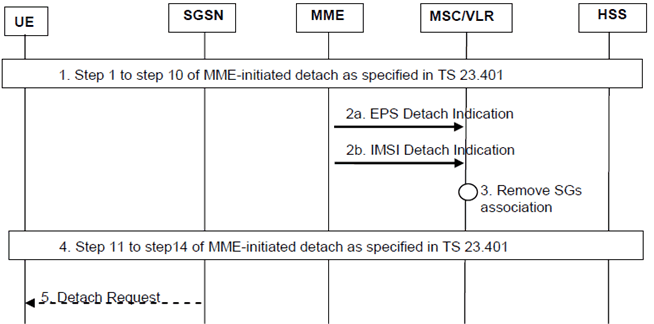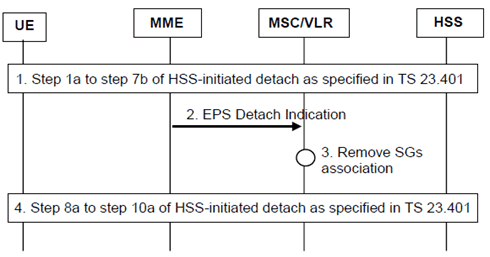Content for TS 23.272 Word version: 19.1.0
1…
4…
5…
5.4…
6…
6.3
6.4…
7…
7.3
7.4…
7.5a…
8…
8.2.4a…
8.3…
8.4…
B…
B.2…
B.2.2…
B.2.3a…
B.2.3a.4…
B.2.4…
B.3…
C…
C.8…
5 Mobility Management
5.1 General
5.1A TAI list and LAI allocation
5.2 Attach procedure
5.3 Detach procedure
5.3.1 UE-initiated Detach procedure
5.3.1A UE-initiated Detach procedure for GERAN/UTRAN with ISR activated
5.3.2 MME-initiated Detach procedure
5.3.2A SGSN-initiated Detach procedure with ISR activated
5.3.3 HSS-initiated Detach procedure
5.3.4 Administration of the MME - MSC/VLR Association
...
...
5 Mobility Management p. 18
5.1 General p. 18
The CS fallback and SMS over SGs in EPS is realized by using the SGs interface mechanism between the MSC Server and the MME. The SMS over SGs NAS procedures are also used for the SMS in MME option.
The use of the "pool-area" concept as specified in TS 23.236 allows to minimize the occurrence of MSC change at CS fallback.
5.1A TAI list and LAI allocation |R9| p. 18
For CS fallback, the fallback procedure is likely to be faster if the network can allocate a Location Area to the UE that is the LA of the overlapping target RAT's coverage. For this situation, the MME should avoid allocating TAI lists that span multiple Location Areas of the target RAT (which may be contrary to the normal usage of the "tracking area list" concept described in TS 23.401).
This can be achieved by:
- configuring the E-UTRAN cell's TAI to take into account the LA boundary of the target RAT;
- the MME being configured to know which TAIs are within which LA; and
- the MME using the TAI of the current E-UTRAN cell to derive the LAI.
- provides normal usage of the "tracking area list" concept, or,
- the TAI list allocation is adjusted, for CS fallback mobiles, to provide "TAI lists that do not span multiple LAs".
- the case of SMS over SGs without overlapping GERAN/UTRAN coverage; and
- the case when not all MSCs in the VPLMN support the SGs interface.
5.2 Attach procedure p. 19
The attach procedure for the CS fallback, SMS over SGs or "SMS in MME" in EPS is realized based on the combined GPRS/IMSI Attach procedure specified in TS 23.060.

Step 1.
The UE initiates the attach procedure by the transmission of an Attach Request (parameters as specified in TS 23.401 including the Attach Type, old LAI and Mobile Station Classmark 2) message to the MME. The Attach Type indicates that the UE requests a combined EPS/IMSI attach and informs the network that the UE is capable and configured to use CS fallback and/or SMS over SGs. If the UE needs SMS service but not CSFB, the UE shall include an "SMS-only" indication in the combined EPS/IMSI Attach Request. See clause 5.6.
A UE that only supports NB-IoT (see TS 23.401) may request SMS service but set the Attach Type to EPS attach instead of combined EPS/IMSI attach.
Step 2.
Step 3 to step 16 of the EPS Attach procedure are performed as specified in TS 23.401 with the differences as described below when "SMS in MME" applies:
Step 3.
- If the MME is enabled to use "SMS in MME" and the MME is not registered with an HSS for that UE (i.e. the MME stores no subscriber data for the UE), the MME performs a registration with HSS as described in Annex C, clause C.8.
- If the MME is enabled to use "SMS in MME" and the MME is registered with an HSS for that UE but has no valid SMS subscriber data (i.e. the MME stores subscriber data for the UE but SMS subscriber data have not been requested before or have been removed by the HSS), the MME may perform a re-registration with HSS as described in Annex C, clause C.8 to obtain SMS subscriber data and to provide the HSS with the MME identity to be used for MT-SMS delivery.
- If the HSS supports "SMS in MME", the HSS follows the registration procedures described in Annex C, clause C.8.
If the Attach Request message includes an Attach Type indicating that the UE requests a combined EPS/IMSI attach, or an NB-IoT-only UE requests SMS and the Attach Type indicates EPS attach, the MME allocates a new LAI for the UE as described in clause 5.1A.
The MME does not perform any registrations with a VLR, (i.e. it skips steps 4 to 7 and no SGs association is created), if the Network Access Mode information in the subscriber data indicate that the subscription has no CS subscriber data; or if the HSS registered the MME for "SMS in MME" for the UE as described in Annex C, clause C.8; or if local configuration, e.g. on MSISDN/IMSI segment, indicates that MME should not perform registration with a VLR for the UE (e.g. NB-IoT only UE).
If the registration with a VLR is required and multiple PLMNs are available for the CS domain, the MME performs selection of the PLMN for CS domain and CS domain operator if the selected CS network is shared network configuration, based on the PLMN ID contained in the current TAI, old LAI and operator selection policies on preferred RAT for CS domain. If the target network is a shared GERAN, the MME shall also take into account the UE capability of support or non-support of GERAN network sharing when selecting the PLMN for the CS domain as specified in TS 23.251. The PLMN selected for CS should be the same that is used for this UE as a target PLMN for PS handovers or for any other mobility procedures related to CSFB. The MME may take any access restrictions provided by the HSS into account, if the network is using separate location areas for GERAN and UTRAN cells. The selected PLMN ID is included in the newly allocated LAI which is sent to MSC/VLR in step 4 and in Attach Accept to the UE.
The MME derives a VLR number based on the newly allocated LAI and the TMSI based NRI as provided by the UE or on the newly allocated LAI and an IMSI hash function defined in TS 23.236. The MME starts the location update procedure towards the new MSC/VLR upon receipt of the subscriber data from the HSS in step 2). This operation marks the MS as EPS-attached in the VLR.
Step 4.
The MME sends a Location Update Request (new LAI, IMSI, MME name, Location Update Type, selected CS domain operator) message to the VLR. MME name is a FQDN string. The cases in which the MME includes the selected CS domain operator towards the VLR are specified in TS 23.251.
Step 5.
The VLR creates an association with the MME by storing MME name.
Step 6.
The VLR performs the normal subscription checks for CS and if all checks are successful performs Location Updating procedure in CS domain.
For GWCN configuration, the MSC selects the core network operator as specified in TS 23.251.
Step 7.
The VLR responds with Location Update Accept (VLR TMSI) to the MME.
Step 8.
The EPS Attach procedure is completed by performing step 17 to step 26 as specified in TS 23.401.
If the UE requested a combined EPS/IMSI Attach, the Attach Accept message includes the parameters as specified in TS 23.401: VLR TMSI and LAI as allocated in step 3 above. The existence of LAI and VLR TMSI indicates successful attach to CS domain.
If the UE requests combined EPS/IMSI Attach Request without the "SMS-only" indication, and if the network supports SGs procedures only for SMS or the network decided to provide "SMS in MME" for the UE, the MME shall indicate in the Attach Accept message that the IMSI attach is for "SMS-only". When the network accepts a combined EPS/IMSI attach without limiting to "SMS-only", the network may provide a "CSFB Not Preferred" indication to the UE.
If the UE requests combined EPS/IMSI Attach Request with the "SMS-only" indication, and if the network supports SGs procedures only for SMS or if it supports CSFB and SMS over SGs or the network decided to provide "SMS in MME" for the UE, the MME shall indicate in the Attach Accept message that the IMSI attach is for "SMS-only".
If the MME provides "SMS in MME" for a UE that requested combined EPS/IMSI Attach, then the TMSI and LAI are provided as specified in clause C.4.2.
The network provides the "SMS-only" or "CSFB Not Preferred" indications based on locally configured operator policies based on e.g. roaming agreement.
The UE behaviour upon receiving such indications is described in TS 23.221.
If the PLMN ID for the CS domain (included in the LAI provided to the UE) differs from the PLMN ID provided as part of the GUTI, the equivalent PLMNs list includes the PLMN ID for the CS domain.
Step 9.
If the VLR has updated the SGs association and if a paging timer is still running for a MT service for this UE, the VLR shall repeat SGs Paging Request towards the updated SGs association.
5.3 Detach procedure p. 21
5.3.1 UE-initiated Detach procedure p. 21
The UE-initiated Detach procedure for the CS fallback and SMS over SGs in EPS is realized based on the MS-Initiated Detach Procedure specified in TS 23.060.

Step 1.
If no SGs association exists for the UE steps 3a-4 are not executed.
The UE initiates the detach procedure by the transmission of a Detach Request (parameters as specified in TS 23.401, Detach Type) message to the MME. Detach Type indicates which type of detach is to be performed, i.e., IMSI Detach only, EPS Detach only or combined EPS and IMSI Detach.
Step 2.
The UE-initiated Detach procedure for E-UTRAN is continued as specified in TS 23.401.
Step 3a.
If the detach type indicates "IMSI Detach only" or "combined EPS and IMSI Detach", the MME sends an IMSI Detach Indication (IMSI) message to the MSC/VLR.
Step 3b.
If the detach type indicates "EPS Detach only", the MME sends an EPS Detach Indication (IMSI) message to the MSC/VLR.
Step 4.
The MSC/VLR removes the association with the MME.
Step 5.
The MME sends a Detach Accept message to the UE as specified in TS 23.401. When the UE receives the Detach Accept message and the Detach Type indicated "EPS Detach only" in step 1, the UE disables E-UTRAN, selects an appropriate GERAN or UTRAN cell.
Step 6.
The UE-initiated Detach procedure for E-UTRAN is completed with step 12 as specified in TS 23.401.
5.3.1A UE-initiated Detach procedure for GERAN/UTRAN with ISR activated p. 22
When ISR is activated, UE initiates detach procedure as specified in clause 5.3.8.2.2 of TS 23.401. The procedure is performed with the exception as follows:
- In step 4, the SGSN sends Detach Notification (Cause, Detach type) message to the associated MME. Cause indicates "IMSI Detach only" when UE performs IMSI Detach only procedure. Otherwise, Cause indicates "complete detach", and Detach type indicates "PS detach" in case of UE-initiated GRPS Detach only procedure, or indicates "combined PS/CS detach" in case of UE-initiated combined GPRS/IMSI detach procedure. If Gs association exists, the SGSN also sends an IMSI Detach Indication (IMSI) message or a GPRS Detach Indication (IMSI) message to the VLR depending on the detach type sent by the UE as specified in clause 6.6.1 of TS 23.060.
- When the MME receives the Detach Notification message, it sends an IMSI Detach Indication (IMSI) message to the MSC/VLR if the cause indicates "IMSI Detach only" or the detach type indicates "combined PS/CS detach", or sends an EPS Detach Indication (IMSI) message to the MSC/VLR if the detach type indicates "PS detach".
- If Cause indicates "IMSI Detach only", the MME shall not deactivate ISR and steps 5 to 9 shall be skipped.
5.3.2 MME-initiated Detach procedure p. 22
The MME-initiated detach procedure for the CS fallback and SMS over SGs in EPS is realized based on the SGSN-Initiated Detach Procedure specified in TS 23.060.

Step 1.
The MME-initiated Detach procedure is performed as specified in TS 23.401.
Step 2a.
If EPS service is not allowed for the UE the MME sends an EPS Detach Indication (IMSI detach from EPS service) message to the MSC/VLR.
Step 2b.
If the UE is required to be IMSI detached, the MME sends an IMSI Detach Indication (IMSI) message to the MSC/VLR.
Step 3.
The MSC/VLR removes the association with the MME.
Step 4.
The MME-initiated Detach procedure is completed with step 11 to step 12 as specified in TS 23.401.
Step 5.
If ISR is activated in SGSN and the UE is EMM combined procedures capable, when SGSN receives Detach Indication message sent from MME with "Detach Type" IE that indicates "Local Detach" or Delete Bearer Request message from SGW for last PDP Context, then the SGSN shall send Detach Request (IMSI Detach) to the UE. The SGSN turns on "EMM Combined UE Waiting Flag". When SGSN may have the capability to use this flag and how the SGSN uses this flag is described in clause 5.5.
If no SGs association exists for the UE steps 2a-3 are not executed.
5.3.2A SGSN-initiated Detach procedure with ISR activated p. 23
When ISR is activated, SGSN initiates detach procedure as specified in clause 5.3.8.3A of TS 23.401. The procedure is performed with the exception as follows:
- In step 4, the SGSN sends Detach Notification (Cause, Detach type) message to the associated MME. If this detach is local to the SGSN (e.g. implicit detach), Cause indicates local detach. Otherwise, Cause indicates complete detach, and Detach type indicates "PS detach". If Gs association exists, the SGSN also sends a GPRS Detach Indication (IMSI) message to the VLR as specified in clause 6.6.2.1 of TS 23.060.
- When the MME receives the Detach Notification message, it sends an EPS Detach Indication (IMSI) message to the MSC/VLR if the detach type indicates "PS detach". If the cause indicates local detach, the MME shall not remove SGs association.
- If Cause indicates local detach, the MME deactivates ISR and steps 5 to 9 shall be skipped.
5.3.3 HSS-initiated Detach procedure p. 23
The HSS-initiated detach procedure for the CS fallback and SMS over SGs in EPS is realized based on the HLR-Initiated Detach Procedure specified in TS 23.060.

Step 1.
The HSS-initiated Detach procedure is performed as specified in TS 23.401.
Step 2.
The MME sends an EPS Detach Indication (IMSI) message to the MSC/VLR.
Step 3.
The MSC/VLR removes the association with the MME.
Step 4.
The HSS-initiated Detach procedure is completed with step 8a to step 10a as specified in TS 23.401.
If no SGs association exists for the UE steps 2-3 are not executed.
5.3.4 Administration of the MME - MSC/VLR Association p. 23
The MME - MSC/VLR association is created at the following occasions:
- Combined EPS/ IMSI attach in clause 5.2.
- Combined TA/LA Update in clause 5.4.
- When an UE changes MME.
- UE-initiated Detach in clause 5.3.1.
- MME initiated Detach in clause 5.3.2.
- HSS initiated Detach in clause 5.3.3.
- Gs association establishment in 2/3G, see TS 23.060.
- MSC/VLR receives a LA update via the A or Iu interface.
- Based on configuration (e.g., if the network is not using NMO-I), MSC/VLR may remove the SGs association when MSC/VLR receives Relocation Complete/Handover Complete during PS to CS SRVCC from E-UTRAN, see TS 23.216.